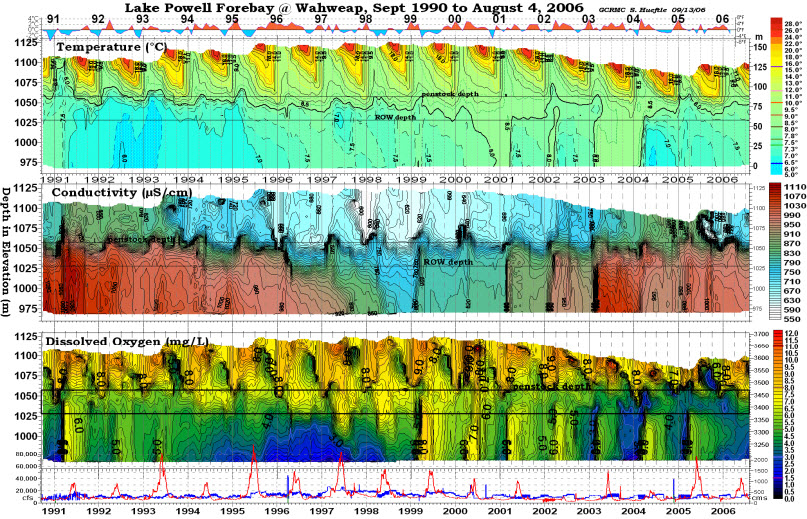Difference between revisions of "WATER QUALITY"
From Glen Canyon Dam AMP
Cellsworth (Talk | contribs) |
Cellsworth (Talk | contribs) |
||
| Line 50: | Line 50: | ||
*[[Media:GCMRC QW Review Agenda - Oct 2017 Final.docx| 2017 Water Quality PEP Agenda]] | *[[Media:GCMRC QW Review Agenda - Oct 2017 Final.docx| 2017 Water Quality PEP Agenda]] | ||
*[[Media:Water Quality Prospectus Final 9-15-2017.docx| 2017 Water Quality PEP Prospectus]] | *[[Media:Water Quality Prospectus Final 9-15-2017.docx| 2017 Water Quality PEP Prospectus]] | ||
| − | + | ===Reading List=== | |
| + | *[http://dx.doi.org/10.5751/ES-07621-200322 Melis et al. 2015. Surprise and Opportunity for Learning in Grand Canyon: the Glen Canyon Dam Adaptive Management Program. Ecology and Society 20(3):22.] | ||
| + | *[http://www.jstor.org/stable/23596748 Cohen et al. 2013. Diel phosphorus variation and the stoichiometry of ecosystem metabolism in a large spring-fed river. Ecological Monographs, Vol. 83, No. 2 (May 2013), pp. 155-176] | ||
| + | *[https://link.springer.com/article/10.1007%2Fs10533-015-0156-6 Corman et al. 2015. Stoichiometric impact of calcium carbonate deposition on nitrogen and phosphorus supplies in three montane streams. Biogeochemistry.] | ||
| + | *[http://onlinelibrary.wiley.com/doi/10.1002/ecm.1229/abstract Corman et al. 2016. Calcium carbonate deposition drives nutrient cycling in a calcareous headwater stream. Ecological Monographs, 86(4), 2016, pp. 448–461] | ||
| + | *[http://www.nrcresearchpress.com/doi/abs/10.1139/F09-003 Hamilton et al. 2008. Biogenic calcite–phosphorus precipitation as a negative feedback to lake eutrophication. Can. J. Fish. Aquat. Sci. 66: 343–350] | ||
| + | *[http://onlinelibrary.wiley.com/doi/10.4319/lo.1972.17.5.0763/pdf Otsuki and Wtzel. 1972. Coprecipitation of phosphate with carbonates in a marl lake. ] | ||
| + | *[[Media:Reynolds1974.pdf| Reynolds and Johnson. 1974. Major element geochemistry of Lake Powell. Lake Powell Research Project Bulletin #5.]] | ||
| + | *[http://onlinelibrary.wiley.com/doi/10.4319/lo.1978.23.4.0585/full Reynolds. 1978. Polyphenol inhibition of calcite precipitation in Lake Powell. Limnol. Oceanogr., 23(4), 1978, 585-597.] | ||
| + | *[[Media:Lake Powell CE-QUAL-W2 review final (1).pdf|ERM’s review of the Lake Powell CE-QUAL-W2 Model]] | ||
| + | *[http://contentdm.lib.byu.edu/ETD/image/etd1755.pdf Williams, N.T., 2007, Modeling dissolved oxygen in Lake Powell using CE-QUAL-W2: Provo, Brigham Young University, thesis.] | ||
| + | *[[Media:Williams Projecting Temp.pdf| Williams, N.T., 2007, Projecting Temperature in Lake Powell and the Glen Canyon Dam Tailrace. Proceedings of the Colorado River Basin Science and Resource Management Symposium]] | ||
| + | *[https://pubs.er.usgs.gov/publication/sir20045120 Hart et al. 2005. Physical and chemical characteristics of Knowles, Forgotten, and Moqui Canyons, and effects of recreational use on water quality, Lake Powell, Arizona and Utah: U.S. Geological Survey Scientific Investigations Report 2004–5120, 43 p.] | ||
| + | *[https://pubs.er.usgs.gov/publication/ofr20131299 Schonauer. 2014. The presence and distribution of polycyclic aromatic hydrocarbons and inorganic elements in water and lakebed materials and the potential for bioconcentration in biota at established sampling sites on Lake Powell, Utah and Arizona: U.S. Geological Survey Open-File Report 2013–1299, 28 p.] | ||
| + | *[[Media:Waddell 1993 Reconnaissance study of trace elements water sediment biota Lake Powell.pdf| Waddell and Wiens. 1993. Reconnaissance study of trace elements in water, sediment, and biota of Lake Powell. ]] | ||
| + | *[https://pubs.er.usgs.gov/publication/70148396 Walters. 2015. Mercury and selenium accumulation in the Colorado River food web, Grand Canyon, USA. Environmental Toxicology and Chemistry, Vol. 34, No. 10, pp. 2385–2394, 2015] | ||
| + | *[http://onlinelibrary.wiley.com/doi/10.4319/lo.1980.25.2.0219/full Gloss. 1980. Advective control of nutrient dynamics in the epilimnion of a large reservoir. Limnol. Oceanogr., 25(2), 1980, 219-228] | ||
| + | *[[Media:Johnson 1981 Oxygen depleted waters Lake Powell.pdf| Johnson and Page. 1981. Oxygen depleted waters: Origin and distribution in Lake Powell, Utah - Arizona. Proceedings of the Symposium on surface water impediments. American Society of Civil Engineers, NY.]] | ||
| + | *[http://onlinelibrary.wiley.com/doi/10.1029/WR015i004p00873/full Johnson and Merritt. 1979. Convective and Advective Circulation of Lake Powell, Utah-Arizona, During 1972-1975. Water Resources Research. 15:4] | ||
| + | *[http://www.nap.edu/catalog/1832.html Stanford and Ward. 1990. Limnology of Lake Powell and the Chemistry of the Colorado River. Colorado River Ecology and Dam Management: Proceedings of a Symposium May 24-25, 1990 Santa | ||
| + | Fe, New Mexico. Chap 5.] | ||
| + | *[http://www.tandfonline.com/doi/full/10.1080/10402381.2017.1293756 Wildman and Vernieu. 2017. Turbid releases from Glen Canyon Dam, Arizona, following rainfall-runoff events of September 2013, Lake and Reservoir Management] | ||
| + | *[http://onlinelibrary.wiley.com/doi/10.1002/hyp.211/abstract Kelly 2001. Influence of reservoirs on solute transport: A regional-scale approach. Hydrol. Process. 15, 1227–1249] | ||
| + | *Stets. 2014. Long-term trends in alkalinity in large rivers of the conterminous US in relation to acidification, agriculture, and hydrologic modification | ||
|} | |} | ||
Revision as of 09:41, 28 October 2017
|
|
Desired Future Condition for Water QualityWater quality with regards to dissolved oxygen, nutrient concentrations and cycling, turbidity, temperature, etc., is sufficient to support natural ecosystem functions, visitor safety and visitor experience to the extent feasible and consistent with the life history requirements of focal aquatic species. |
| --- |
--- |
--- |
|---|
